Blog
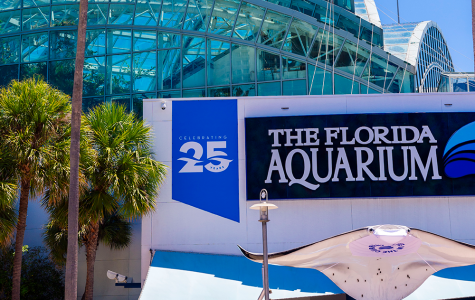 In blunt terms, the exhibit The Florida Aquarium chose to commemorate its 25th anniversary could be called a bunch of junk.
In blunt terms, the exhibit The Florida Aquarium chose to commemorate its 25th anniversary could be called a bunch of junk.
But Aquarium President and CEO Roger Germann doesn’t see it that way and neither will those who visit “Washed Ashore: Art to Save the Sea.”.
Because of the Coronavirus, The Florida Aquarium temporarily closed shortly after the exhibit opened. But now The Aquarium is reopened – with strict safety protocols – and the public again can view Washed Ashore, which will remain here until October, two months longer than originally planned.
The junk actually is plastic debris that has been collected from beaches and transformed into remarkable marine life artwork that convey the magnitude of plastic pollution and the urgency of addressing it.
“We felt Washed Ashore was the perfect exhibit to launch our 25th anniversary,” Germann said recently. “We wanted to celebrate a best-in-class aquarium with a best-in-class art exhibit,” noting that Washed Ashore has been showcased at the Smithsonian and other prestigious institutions around the nation.
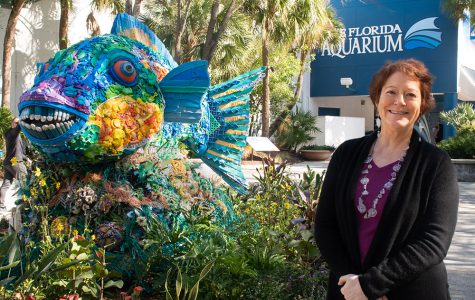 Washed Ashore has four traveling exhibits. This one was specifically “curated” for The Aquarium to highlight Florida issues.
Washed Ashore has four traveling exhibits. This one was specifically “curated” for The Aquarium to highlight Florida issues.
Furthermore, Germann said Washed Ashore represents a “pivot point” that will allow The Florida Aquarium to “do more advocacy on the problems of our waterways, which also are tied to the health of our economy.”
The Aquarium, of course, always has emphasized protecting the Blue Planet, and has led numerous conservation efforts such as the Skip the Straw campaign.
But Germann said, “We want to do even more advocacy to protect wildlife and plastics are at the top of the threats to our waterways. Washed Ashore illustrates how The Aquarium can tell a story that engages the public while highlighting a critical issue.”
This aligns perfectly with the goals of Angela Haseltine Pozzi, the Oregon artist who created Washed Ashore and was on hand as the exhibit was being assembled at The Aquarium in February.
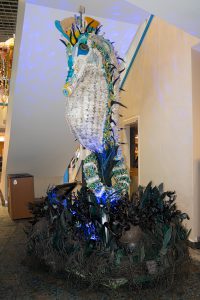 She told me then: “Our mission is to build an exhibit of aesthetically powerful art to educate a global audience about the plastic pollution in the ocean and waterways and to start positive changes in consumer habits.”
She told me then: “Our mission is to build an exhibit of aesthetically powerful art to educate a global audience about the plastic pollution in the ocean and waterways and to start positive changes in consumer habits.”
Friendly and focused, she led me on a tour of the exhibit, pointing out the often-bizarre parts of the large sculptures (including a bowling pin, gas mask and urinal) and stopping to make final adjustments to the elaborate coral reef presentation developed specifically for The Florida Aquarium. She wants things just right.
The displays, such as a giant parrot fish, white shark and seahorse, are colorful and dramatic. Pozzi tries to make them as anatomically correct as possible. But look closely and you see they consist of countless plastic items, including such things as toy shovels, toothbrushes, flip-flops, toilet brushes, buoys, cigarette lighters, bleach containers, baby pacifiers, buckets and plastic bottles – lots and lots of plastic bottles. (No hazardous material is used.)
“Remember all that plastic was purchased before it became pollution,” Pozzi said, “Consumers and manufacturers can learn to modify behavior.”
This is about more than litter, she stressed. Plastic “covers the entire water column, not just the surface. By 2050 there will be more plastic in the ocean than fish.”
She warned that the plastics break down into microplastic that enter the food chain, accumulate in animals all the way to top predators, with damaging effects. The Florida Aquarium team also has sought to educate visitors about such subtle threats.
Not to mention the more direct wildlife carnage.
“Plastic bags look exactly like jellyfish to turtles. Plastics start to absorb smells, so they look and smell just like what the turtles eat. The plastic entangles birds and kills them.”
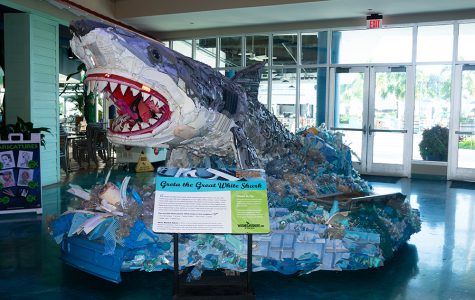 Fish and other and other marine creatures try to eat the floating plastic, tearing off and often swallowing chunks, a dangerous occurrence the Washed Ashore illustrates with a fish made entirely of plastics pieces that clearly been bitten.
Fish and other and other marine creatures try to eat the floating plastic, tearing off and often swallowing chunks, a dangerous occurrence the Washed Ashore illustrates with a fish made entirely of plastics pieces that clearly been bitten.
Pozzi, a former art teacher, always has been passionate about art and the natural world. But tragedy led to her Washed Ashore inspiration.
“I was married to my husband, Craig Pozzi, for 25 years. He suddenly collapsed” and later died from the complications of a brain tumor in 2002. “I was 47 with a teenage daughter. I decided to go to the ocean to heal. But as I walked the beaches, and saw all the trash, I found the beaches needed healing more than I did. “
Always a “3D” artist who could visualize how different materials could be made into art, she formed the idea of turning the beach trash into sculptures with a conservation message.
“I wanted to make a difference,” she said. “It was a good reason for living.”
(She ultimately remarried and her husband handles marketing for her organization.)
Since she started the non-profit Washed Ashore in 2010, 25 million people have seen her work. Her team has used 26 tons of plastic waste and created 80 works for the four traveling exhibits. She has a staff of 10, including other artists, though she is the lead artist for most pieces. Thousands of volunteers help out, particularly gathering and sorting the junk, all of which comes from Oregon beaches.
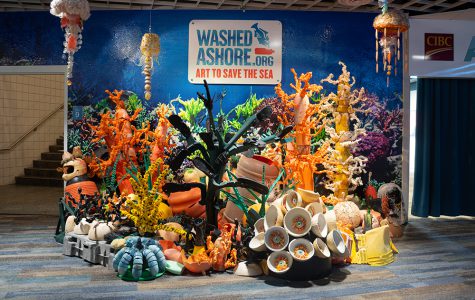 “As you can imagine, it is very labor intensive.”
“As you can imagine, it is very labor intensive.”
Everything must be thoroughly cleansed. The emphasis on thorough sanitation came even before the pandemic.
“We are in a rural area, so most of the waste comes from the middle ocean. We don’t normally find needles like you might next to an urban area. But we take every precaution. Always wearing gloves. We disinfect things with vinegar, which is biodegradable.”
More works always are being constructed and, unfortunately, she never has to worry about running out of supplies: “More comes in with every tide.”
In the major sculptures, the plastic items are attached with wire and screws. The only glue used is on the small murals or masks that are hung on the wall.
At one rendering she pointed to a piece of a plastic chair that had been screwed into place: “People don’t realize you can repair plastic chairs and other things and not just throw them away.”
She is proud of the dedication of her staff and volunteers. “There is a lot of hard work and long hours that go into to all this, but there really is a team spirit.”
The sculptures not only require a lot for work, they also are expensive. The bigger sculptures are built onto stainless-steel frames that may cost $20,000 each. Shipping the sculptures across the country on three flatbed trucks alone may cost $50,000.
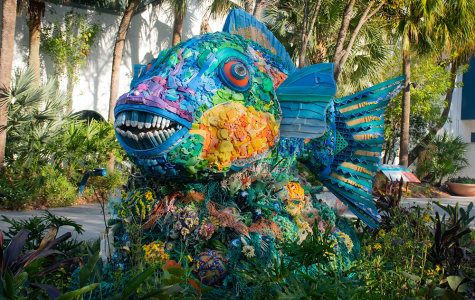 “So, when The Florida Aquarium leases the exhibit, it gives us our operating costs and helps us keep going.”
“So, when The Florida Aquarium leases the exhibit, it gives us our operating costs and helps us keep going.”
Germann said The Aquarium is “honored” the Vinik Family Foundation made Washed Ashore possible with a $250,000 donation.
“Jeff and Penny Vinik always are world class with whom they associate and this is the kind of exhibit that is near and dear to their hearts. Telling stories through compelling art.”
He noted that Jeff Vinik, the owner of the Tampa Bay Lightning hockey team, is emphasizing environmental sustainability at his Water Street Tampa development near The Aquarium. Penny Vinik is a champion of public art who has sought to make to make fun, cultural activities accessible to families of all incomes.
Germann said it is by design that one of the most striking sculptures, the large parrotfish, is located outside The Aquarium’s entrance, so people can enjoy it “whether you come through our doors or not.”
He said, “It was a huge hit with people before we had to close and the feedback we’re getting from guests now is great. It’s fun, intriguing and colorful but people also are impressed by the learning part, seeing plastic pollution depicted that way.”
He said watching passersby encounter the parrotfish is revealing.
“I have not seen one person walking by the parrot fish who hasn’t stopped to take a selfie. It’s amazing to see the effects of the whole exhibit, its interaction with people, the energy and excitement it generates. People are not expecting to see trash turn into art in such a dynamic way.”
Such observations encourage Pozzi. Despite encountering an endless stream of pollution, she remains optimistic. Pozzi hopes Washed Ashore will not only increase concern about plastic threat, but will inspire creative responses.
“I think we’ve stopped teaching children to be resourceful. I hope this helps them see there are other ways of looking at things. I really feel what will get us out of our environmental issues is resourceful young people with new ideas. We need that kind of thinking.”
More
to Sea
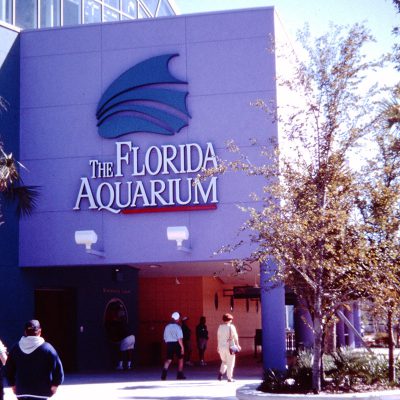
25th Anniversary: Sandy Freedman...
Former Tampa Mayor Sandy Freedman said some daring was required to find a home for The Florida Aquarium. She recalled: “It had originally been planned for Clearwater and then it proposed all over th...
Read More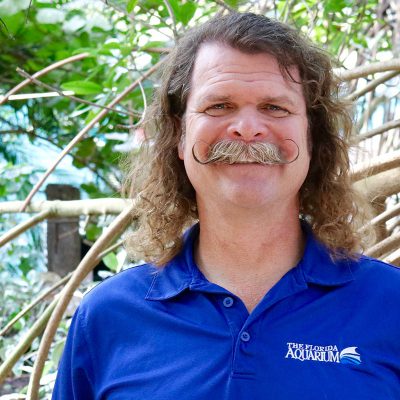
25th Anniversary: Eric Hovland’s Journe...
As a young biologist with a lifelong passion for wildlife, Eric Hovland was thrilled to be hired in November 1994 at The Florida Aquarium, which was still under construction. “I had heard about this...
Read More